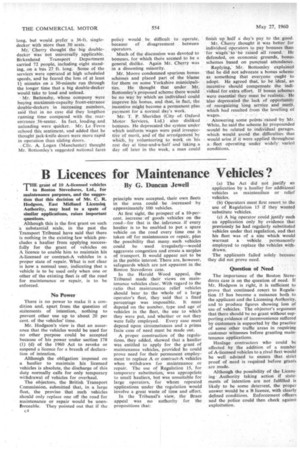B Licences for Maintenance Vehicles?
Page 54

If you've noticed an error in this article please click here to report it so we can fix it.
By G. Duncan Jewell
TR' grant of 10 A-licensed vehicles to Boston Stevedores, Ltd., for maintenance purposes, and the suggestion that this decision of Mr. C. R. Hodgson, East Midland Licensint Authority, may lead to a spate of similar applications, raises important questions.
Although this is the first grant on such a substantial scale, in the past the Transport Tribunal have said that there is nothing in the existing law which precludes a haulier from applying successfully for the grant of vehicles on A licence to enable him to maintain his A-licensed or contract-A vehicles in a proper state of repair. What is not clear is how a normal user, indicating that a vehicle is to be used only when one or other of the existing fleet Is off the road for maintenance or repair, is to be enforced.
No Power
There is no power to make it a condition and, apart from the question of statements of intention, nothing to prevent other use up to about 20 per cent. of the vehicles' time.
Mr. Hodgson's view is that an assurance that the vehicles would be used for no other purpose could be accepted because of his power under section 178 (1) (d) of the 1960 Act to revoke or suspend a licence for a breach of declaration of intention.
Although the obligation imposed on a haulier to maintain his licensed vehicles is absolute, the discharge of this duty normally calls for only temporary withdrawal of vehicles for overhaul.
The objectors, the British Transport Commission, submitted that, in a large fleet, the proviso that such vehicles should only replace one off the road for maintenance or repair would be unenforceable. They pointed out that if the ca principle were accepted, their own fleets in the area could be .increased by approximately 100 vehicles.
At first sight, the prospect of a 10-percent. increase :of goods vehicles on the road—for that is the, inference. if every haulier is to be enabled to put a spare vehicle on the road every time one is taken off for maintenance or repair, plus the possibility that many, such, vehicles could be used irregularly—would aggravate congestion and create a surplus of transport. It would appear not to be in the public interest. There are, however, safeguards which are not apparent in the Boston Stevedores case.
In the Harold Wood appeal, the Tribunal made their views on maintenance vehicles clear. With regard to the ratio that maintenance relief vehicles should bear to the whole of a large operator's fleet, they said that a fixed percentage was impossible. It must depend on the number, type and age of vehicles in the fleet, the use to which they were put, and whether or not they were fully employed. Every case must depend upon circumstances and a prima facie case of need must be made out.
A proper construction of the regulations, they added, showed that a haulier was entitled to apply for the grant of maintenance vehicles, provided he could prove need for their permanent employment to replace A or contract-A vehicles when withdrawn for maintenance . or repair. The use of Regulation 15, for temporary substitution, was appropriate to small hauliers, but was unsuitable for large operators, for whom repeated applications under the regulation would involve a great waste of time and effort.
In the Tribunal's view, the Brace appeal was no authority for the propositions that: (a) The Act did not justify an application by a haulier for additional vehicles as mainteance or relief vehicles.
(b) Operators must first resort to the use of RegUlation 15 if they wanted substitute vehicles.
(c) A big operator could jnstify such an application only by evidence that previously he had regularly substituted vehicles under that regulation, and that his fleet was of a size which would warrant a vehicle permanently employed to replace the vehicles withdrawn.
The applicants failed solely because they did not prove need.
Question of Need
The importance of the Boston Stevedores case is on the question of need. If Mr. Hodgson is right, it is sufficient to prove that continued resort to Regulation 15 has become a nuisance both to the applicant and the Licensing Authority, and to produce figures showing loss of use of vehicles. The objector's argument that there should be no grant without supporting evidence of inconvenience suffered by customers is supported by the practice of some other traffic areas in requiring customer witnesses before granting maintenance applications.
Haulage contractors who could be affected by the addition of a number of A-licensed vehicles to a rival fleet would be well advised to ensure that strict proof of need is required before grants are made.
Although the possibility of the Licensing Authority taking action if statements of intention are not fulfilled is likely to be some deterrent, the proper answer would be a B licence, with clearly defined conditions. Enforcement officers and the police could then check against exploitation.
















































































































